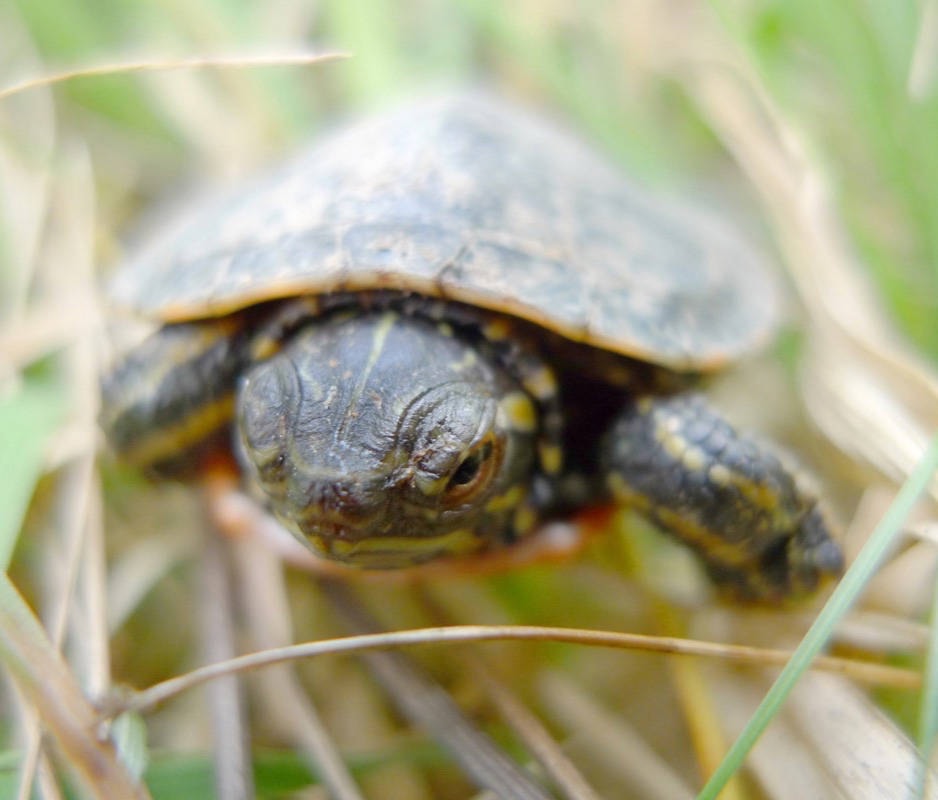Submitted by Habitat Acquisition Trust
A row of turtles basks on a log in the lake, the sun warms their bodies like contented sunbathers. It’s a delightful, idyllic scene – or is it?
Take a closer look at those turtles. Do they have a vivid red-orange underbelly? Or is the belly yellow and the cheeks with a blushing red to brown streak?
If you’ve spotted a turtle that appears painted red to orange on its belly, you’re lucky to be looking at Vancouver Island’s only remaining native species of freshwater turtle, a member of the endangered coastal population of western painted turtles (Chrysemys picta bellii). A welcome sight and an animal that needs all the help it can get to keep its remaining wetland habitat livable.
If you’ve spotted a turtle with a yellow belly, “red ears”, or a bold yellow z-stripe on the side of its face, you are looking at an abandoned pet.
Red-eared sliders (Trachemys scripta elegans) and yellowbelly sliders (Trachemys scripta scripta) can live to 50 years old, and grow to over 30 centimetres long.
Pet owners that find themselves unwilling to honour a life-long commitment to their turtles look to the great outdoors - Instead of responsibly finding their pet a new home or surrendering pets to an animal shelter. Yes, many turtles – at least six species – have been abandoned in our lakes and ponds.
Unfortunately, the wild is not the place for domestically raised, non-native species. Of all the species released in B.C., only one – the red-eared slider – is released in sufficient number to allow males and females to find each other.
Other turtles released in B..C include the common snapping turtle (Chelydra serpentine), a map turtle (Graptemys sp.), Reeve’s turtle (Chinemys reevsi), European pond terrapin (Emys orbicularis), and one species of softshell turtle (Apalone sp.). These five are disctinctive and cannot be mistaken for our native painted turtle.
If an abandoned pet slider survives the ordeal of going from a cozy, all-inclusive home to fending for itself outdoors, it now poses a serious risk to coexisting with Western painted turtles.
Habitat Acquisition Trust has found sliders frequently have respiratory disease when rescued from the wild, and this could be spread to native painted turtles.
Disease is not the only problem, introduced sliders compete with native turtles for basking habitat, food, and nesting sites. Not only that, but sliders increase pressure on other species as they gobble up plants, crustaceans, aquatic insects, snails, amphibians, and their eggs.
As bigger turtles, sliders can easily dominate basking logs. Basking spots are not only a nice place to catch some sun, they are essential to maintaining healthy metabolic rate and digestive function in painted turtles.
Suitable habitat for painted purtles is essential, yet in the Victoria region more than 80 per cent of pre-colonial wetlands have already been lost, and water quality has declined in the remaining waterbodies with alteration of flow, as well as modern use of industrial chemicals, fertilizers, and pesticides.
Now painted purtles have to cope with abandoned pets on top of habitat loss and degradation.
Red-eared sliders are among the top 100 worst invaders recognized by the International Union for Conservation of Nature. But at least these non-native sliders can’t hatch babies in British Columbia’s cool northern climate … right?
While this was once thought to be true, it turns out our worst fears about the invaders are confirmed. B.C.’s first record of successfully hatched slider nestlings in the wild came in 2015, during Coastal Painted Turtle Project nest monitoring in Delta.
Before this, researchers had only found slider nests with partially developed embryos, and nearly successful but dead hatchlings.
The survival of slider hatchlings in 2015 is concerning for a number of reasons. With projected climate warming, the nesting success of sliders may only increase. Not only that but, slider’s lower age of maturity could provide a reproductive edge in overtaking our endangered painted turtles locally.
So what’s to be done about this rival for precious habitat? Aimee Mitchell and researchers at the Coastal Painted Turtle Project recommend recording non-native turtle and nest observations, removing non-native turtles before successful breeding, monitoring the area following removal, and public education on non-native turtles.
Habitat Acquisition Trust welcomes your observations of turtles and turtle nests on South Vancouver Island and the Gulf Islands. Please send your observations, with clear photographs whenever possible, to hatmail@hat.bc.ca.
